目录
例1 字符串匹配例题 - 题目 - Daimayuan Online Judge
例2 最小循环覆盖 - 题目 - Daimayuan Online Judge
例3 [UVA 12467] Secret word - 题目 - Daimayuan Online Judge
例1 字符串匹配例题 - 题目 - Daimayuan Online Judge
例2 [CF 126B] Password - 题目 - Daimayuan Online Judge
KMP
用 O(n+m) 时间复杂度解决字符串匹配问题
计算一个字符串s与p的前缀p[1]…p[j]的最长公共子串的长度
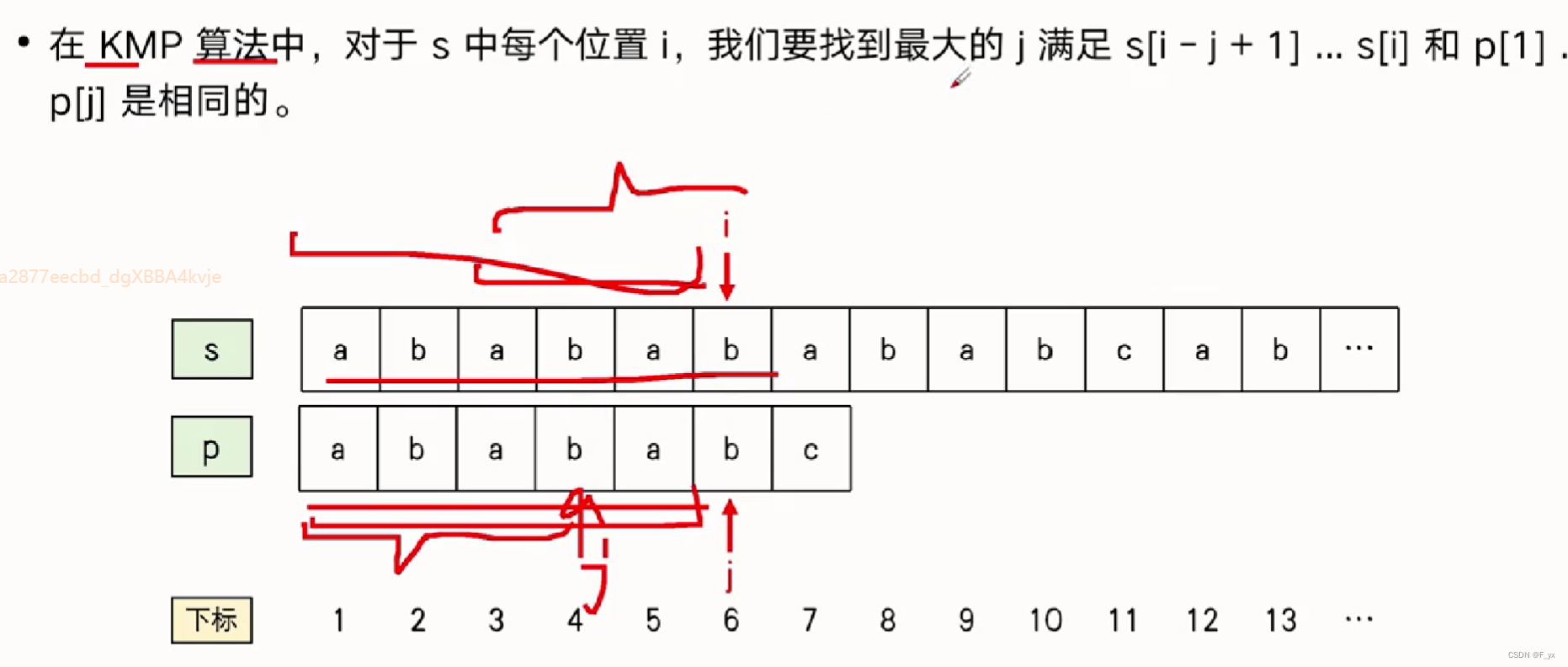
nxt[ j ] = k:k < j 且 p[ 1 ]…p[ k ] 和 p[ j-k+1 ]…p[ j ] 完全相等
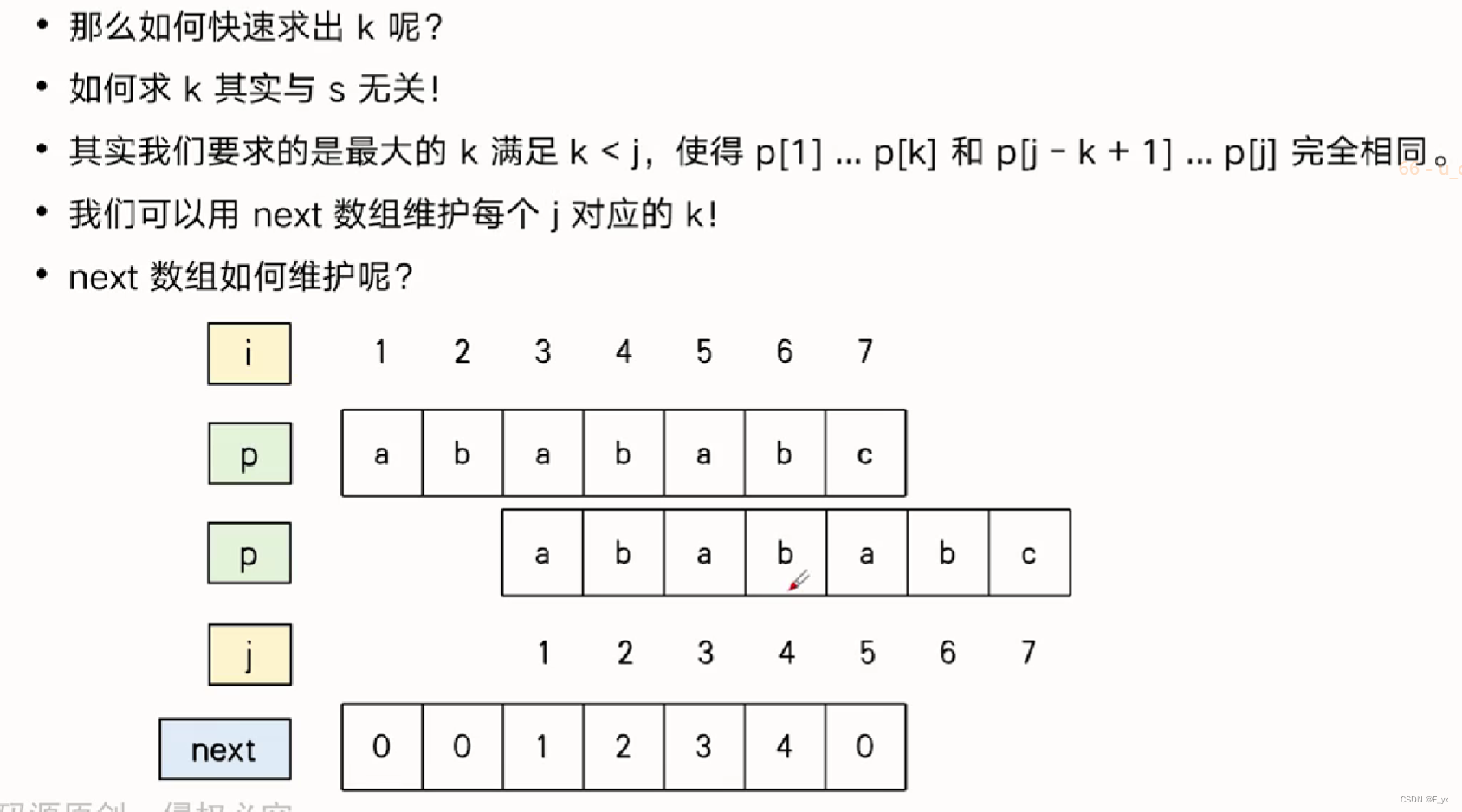
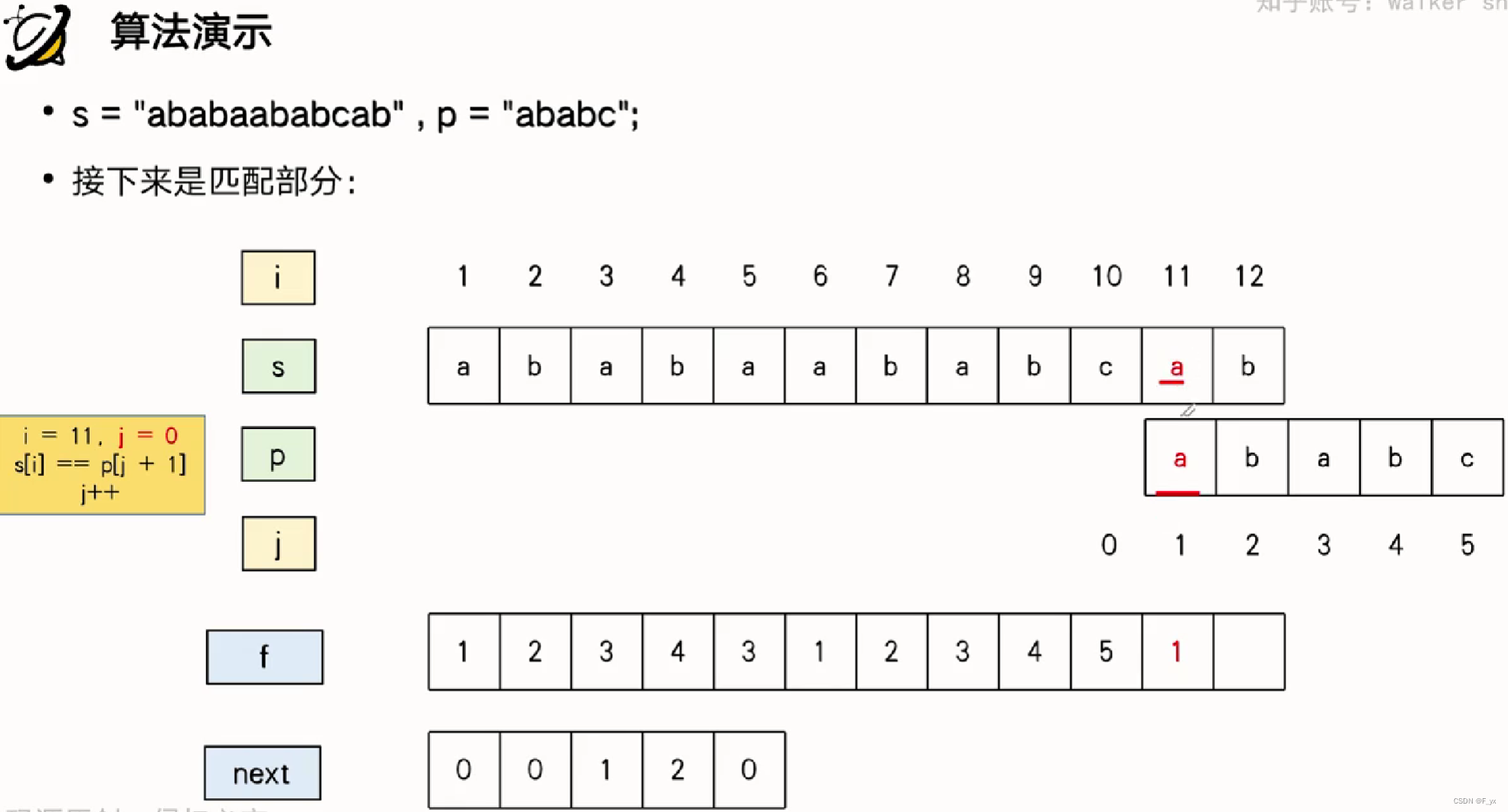
模板1:
#include<bits/stdc++.h>
using namespace std;
int n, m;
int nxt[100001], f[100001];//nxt[i]=j:记录p串以i结尾的长度为j的后缀子串与p串前缀 前j位相等
// j<i
//f[i]=j:p对应的从s[i]起的长度j
char s[100002], p[100002];
void kmp() {
n = strlen(s + 1); m = strlen(p + 1);
int j = 0;
nxt[1] = 0;
for (int i = 2; i <= m; i++) {
while (j > 0 && p[j + 1] != p[i])//当j=0时,无法再向前更新
j = nxt[j];
if (p[j + 1] == p[i])//当找不到对应相等的字符时j=0
j++;
nxt[i] = j;
}
j = 0;
for (int i = 1; i <= n; i++) {//遍历s
while ((j == m) || (j > 0 && p[j + 1] != s[i]))
j = nxt[j];
if (p[j + 1] == s[i])
j++;
f[i] = j;
}
}模板2
#include<bits/stdc++.h>
using namespace std;
int n, m, t;
int nxt[200005];
char s[100002], p[200005];
void kmp() {
n = strlen(s + 1);
m = strlen(p + 1);
p[m + 1] = '#';
for (int i = m + 2, j = 1; j <= n; i++, j++)
p[i] = s[j];
int j = 0;
nxt[1] = 0;
for (int i = 2; i <= n+m+1; i++) {
while (j > 0 && p[j + 1] != p[i])//当j=0时,无法再向前更新
j = nxt[j];
if (p[j + 1] == p[i])//当找不到对应相等的字符时j=0
j++;
nxt[i] = j;
}
}例1 字符串匹配例题 - 题目 - Daimayuan Online Judge
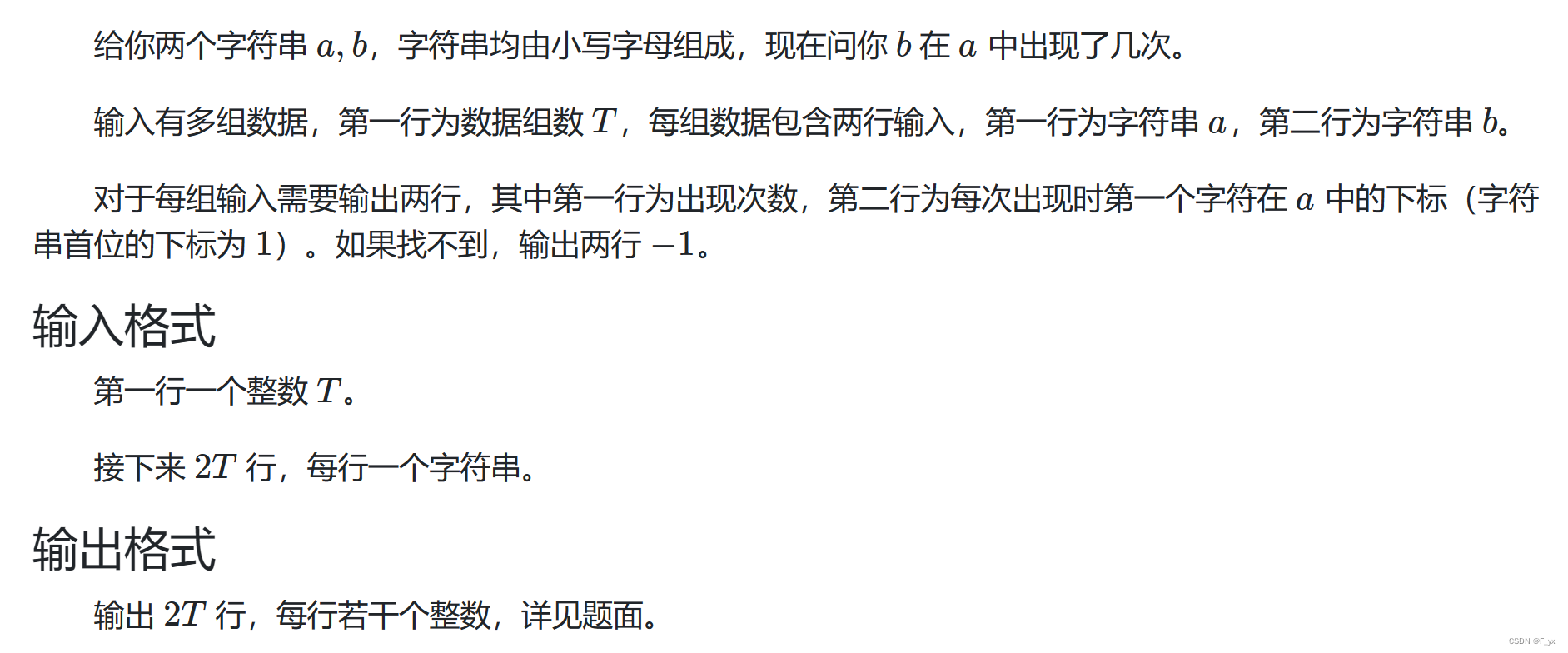
样例输入
3
abababa
aba
aaaaaa
bb
abcabcab
abcab样例输出
3
1 3 5
-1
-1
2
1 4数据规模
对于所有数据,保证 1≤T≤10,1≤|a|,|b|≤10^5,字符串均由小写字母构成。
代码1(两字符串先求nxt[ ]再求f[ ]):
#include<bits/stdc++.h>
using namespace std;
int n, m, t;
int nxt[100001], f[100001];
char s[100002], p[100002];
void kmp() {
n = strlen(s + 1);
m = strlen(p + 1);
int j = 0;
nxt[1] = 0;
for (int i = 2; i <= m; i++) {
while (j > 0 && p[j + 1] != p[i])//当j=0时,无法再向前更新
j = nxt[j];
if (p[j + 1] == p[i])//当找不到对应相等的字符时j=0
j++;
nxt[i] = j;
}
j = 0;
for (int i = 1; i <= n; i++) {//遍历s
while ((j == m) || (j > 0 && p[j + 1] != s[i]))
j = nxt[j];
if (p[j + 1] == s[i])
j++;
f[i] = j;
}
int ans = 0;
for (int i = 1; i <= n; i++)
if (f[i] == m)++ans;
if (!ans)printf("-1\n-1\n");
else {
printf("%d\n", ans);
for (int i = 1; i <= n; i++)
if (f[i] == m)
printf("%d ", i - m + 1);
printf("\n");
}
}
int main() {
scanf("%d", &t);
while (t--) {
scanf("%s%s", s + 1, p + 1);
kmp();
}
return 0;
}代码2(字符串合并求nxt):
#include<bits/stdc++.h>
using namespace std;
int n, m, t;
int nxt[200005];
char s[100002], p[200005];
void kmp() {
n = strlen(s + 1);
m = strlen(p + 1);
p[m + 1] = '#';
for (int i = m + 2, j = 1; j <= n; i++, j++)
p[i] = s[j];
int j = 0;
nxt[1] = 0;
for (int i = 2; i <= n+m+1; i++) {
while (j > 0 && p[j + 1] != p[i])//当j=0时,无法再向前更新
j = nxt[j];
if (p[j + 1] == p[i])//当找不到对应相等的字符时j=0
j++;
nxt[i] = j;
}
int ans = 0;
for (int i = m + 2; i <= n + m + 1; i++)
if (nxt[i] == m)++ans;
if (!ans)printf("-1\n-1\n");
else {
printf("%d\n", ans);
for (int i = m + 2; i <= n + m + 1; i++)
if (nxt[i] == m)
printf("%d ", i - 2 * m);
printf("\n");
}
}
int main() {
scanf("%d", &t);
while (t--) {
scanf("%s%s", s + 1, p + 1);
kmp();
}
return 0;
}例2 最小循环覆盖 - 题目 - Daimayuan Online Judge

样例输入1
bcabcabcabcab样例输出1
3样例输入2
aaaaaaa样例输出2
1数据规模
对于所有数据,保证 1≤|a|≤10^5,字符串均由小写字母构成。
代码:
#include<bits/stdc++.h>
using namespace std;
int n, m, t;
int nxt[200005];
char s[100002], p[200005];
void kmp() {
m = strlen(p + 1);
int j = 0;
nxt[1] = 0;
for (int i = 2; i <= m; i++) {
while (j && p[j + 1] != p[i])
j = nxt[j];
if (p[j + 1] == p[i])j++;
nxt[i] = j;
}printf("%d", m - nxt[m]);
}
int main() {
scanf("%s", p + 1);
kmp();
return 0;
}最小循环节vs最小循环覆盖的区别,最小循环覆盖字符串的最后一段可能不是完整的循环子串
最小循环节长度:len-nxt[len]
求最小循环节问题_搬砖的小孩有肉吃的博客-CSDN博客_最小循环节
例3 [UVA 12467] Secret word - 题目 - Daimayuan Online Judge

样例输入
listentothesilence样例输出
sil数据规模
对于所有数据,保证 1≤|s|≤10^5,字符串均由小写字母构成。
代码:
#include<bits/stdc++.h>
using namespace std;
int n, m, t;
int nxt[200005];
char s[200005];
void kmp() {
n = strlen(s + 1);
s[n + 1] = '#';//倒序存入
for (int i = n * 2 + 1, j = 1; j <= n; j++, i--)
s[i] = s[j];
int j = 0;
nxt[1] = 0;
for (int i = 2; i <= n * 2 + 1; i++) {
while (j && s[j + 1] != s[i])
j = nxt[j];
if (s[j + 1] == s[i])j++;
nxt[i] = j;
}int ans = 0;
for (int i = n + 2; i <= n * 2 + 1; i++)
ans = max(ans, nxt[i]);
for (int i = ans; i > 0; i--)
printf("%c", s[i]);
}
int main() {
scanf("%s", s + 1);
kmp();
return 0;
}EXKMP
扩展KMP(Z algorithm):以O(n)时间复杂度求出一个字符串s和它的任意后缀s[i]…s[n]的最长公共前缀的长度
KMP vs EXKMP:next[ ]前者是到字符s[ i ]结束,后者是从字符s[ i ]开始
z[ i ]:表示字符串 s 和后缀 s[ i ]…s[ n ]的最长公共前缀的长度


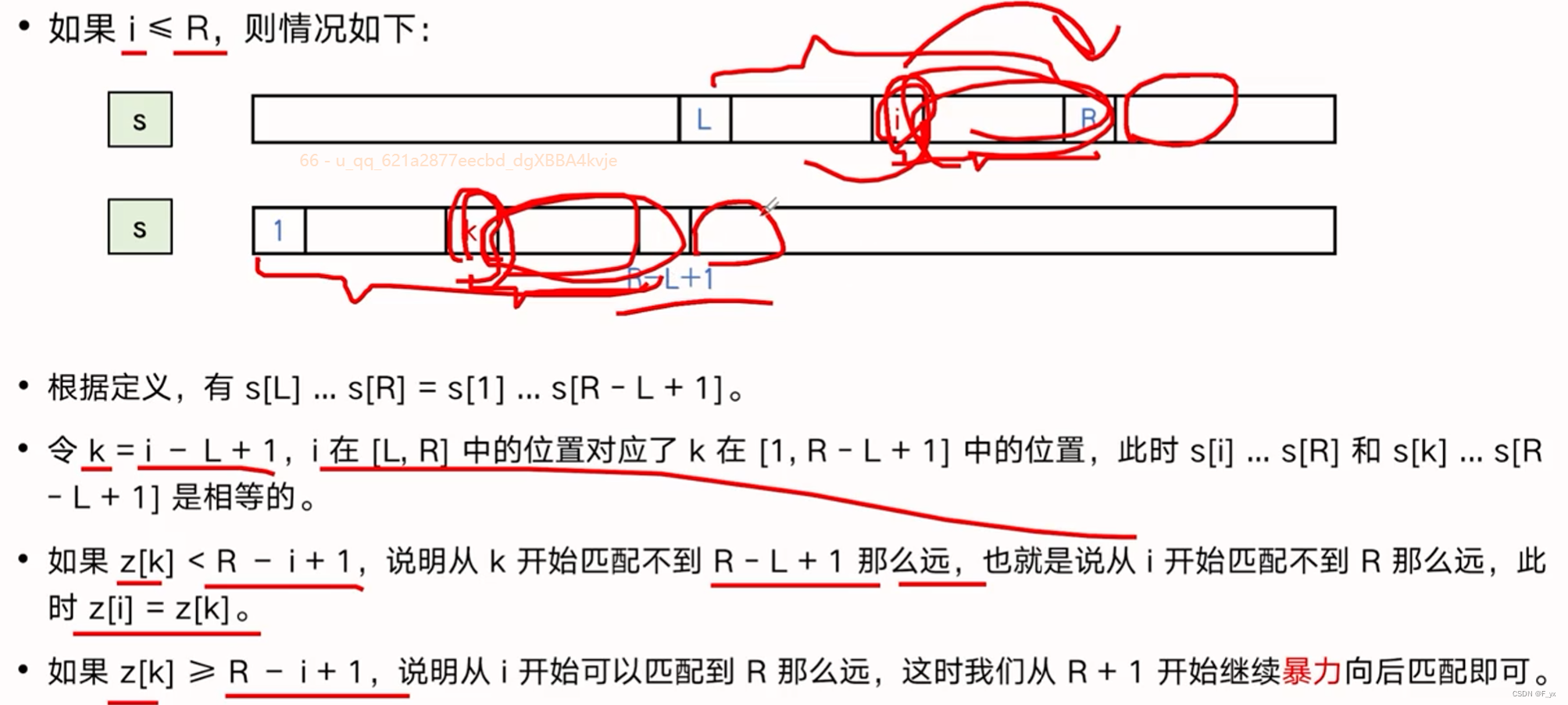

模板:
#include <bits/stdc++.h>
using namespace std;
int z[100001], n;
char s[100002];
void exkmp() {
int L = 1, R = 0;
z[1] = 0;
for (int i = 2; i <= n; i++) {
if (i > R)z[i] = 0;
else {
int k = i - L + 1;//当前i在[L,R]的相对位置,即k在[1,R-L+1]的位置
z[i] = min(z[k], R - i + 1);//当z[k]>R-i+1时,k可向后匹配的位置与R以后的串不一定相等
}
//暴力匹配
while (i + z[i] <= n && s[z[i] + 1] == s[i + z[i]])//i+z[i]存在且可匹配
z[i]++;
//更新区间[L,R]
if (i + z[i] - 1 > R)//从i位置向后匹配可到R之后
L = i, R = i + z[i] - 1;
}
}注意:s[ z[i]+1 ] == s[ i+z[i] ],n=strlen( s+1 )
例1 字符串匹配例题 - 题目 - Daimayuan Online Judge
代码:
#include <bits/stdc++.h>
using namespace std;
int z[200005], n, m, t;
char s[100002],p[200004];
void exkmp() {
int L = 1, R = 0;
z[1] = 0;
n = strlen(s + 1);
m = strlen(p + 1);
p[m + 1] = '#';
for (int i = m + 2, j = 1; j <= n; j++, i++)p[i] = s[j];
for (int i = 2; i <= n + m + 1; i++) {
if (i > R)z[i] = 0;
else {
int k = i - L + 1;
z[i] = min(z[k], R - i + 1);
}
while (i + z[i] <= n + m + 1 && p[i + z[i]] == p[1 + z[i]])
z[i]++;
if (i + z[i] - 1 > R)
L = i, R = i + z[i] - 1;
}
int ans = 0, x = 0;
for (int i = m+2; i <= n+m+1; i++) {
if (z[i] == m)ans++;
}if (!ans)printf("-1\n-1\n");
else {
printf("%d\n", ans);
for (int i = m + 2; i <= n + m + 1; i++)
if (z[i] == m)printf("%d ", i - m - 1);
printf("\n");
}
}
int main() {
scanf("%d", &t);
while (t--) {
scanf("%s%s", s + 1, p + 1);
exkmp();
}
return 0;
}例2 [CF 126B] Password - 题目 - Daimayuan Online Judge

样例输入1
fixprefixsuffix样例输出1
fix样例输入2
abcdabc样例输出2
Just a legend数据规模
对于所有数据,保证 1≤|s|≤10^6,字符串均由小写字母构成。
代码:
#include <bits/stdc++.h>
using namespace std;
int z[1000005], n;
char s[1000002];
void exkmp() {
n = strlen(s + 1);
int L = 1, R = 0;
z[1] = 0;
for (int i = 2; i <= n; i++) {
if (i > R)z[i] = 0;
else {
int k = i - L + 1;
z[i] = min(z[k], R - i + 1);
}
while (i + z[i] <= n && s[z[i] + 1] == s[i + z[i]])
z[i]++;
if (i + z[i] - 1 > R)
L = i, R = i + z[i] - 1;
}
int x = 0, ans = 0;
for (int i = 2; i <= n; i++) {
if (i + z[i] - 1 == n)//满足在后缀出现
if (x >= z[i])
ans = max(ans,z[i]);//x一定小于i,x>=z[i]表示该前缀一定在中间出现过
x = max(x, z[i]);
}
if (!ans)printf("Just a legend");
else for (int i = 1; i <= ans; i++)printf("%c", s[i]);
}
int main() {
scanf("%s", s + 1);
exkmp();
return 0;
}G - Blue Jeans
The Genographic Project is a research partnership between IBM and The National Geographic Society that is analyzing DNA from hundreds of thousands of contributors to map how the Earth was populated.
As an IBM researcher, you have been tasked with writing a program that will find commonalities amongst given snippets of DNA that can be correlated with individual survey information to identify new genetic markers.
A DNA base sequence is noted by listing the nitrogen bases in the order in which they are found in the molecule. There are four bases: adenine (A), thymine (T), guanine (G), and cytosine (C). A 6-base DNA sequence could be represented as TAGACC.
Given a set of DNA base sequences, determine the longest series of bases that occurs in all of the sequences.
Input
Input to this problem will begin with a line containing a single integer n indicating the number of datasets. Each dataset consists of the following components:
- A single positive integer m (2 <= m <= 10) indicating the number of base sequences in this dataset.
- m lines each containing a single base sequence consisting of 60 bases.
Output
For each dataset in the input, output the longest base subsequence common to all of the given base sequences. If the longest common subsequence is less than three bases in length, display the string "no significant commonalities" instead. If multiple subsequences of the same longest length exist, output only the subsequence that comes first in alphabetical order.
Sample
| Inputcopy | Outputcopy |
|---|---|
3 2 GATACCAGATACCAGATACCAGATACCAGATACCAGATACCAGATACCAGATACCAGATA AAAAAAAAAAAAAAAAAAAAAAAAAAAAAAAAAAAAAAAAAAAAAAAAAAAAAAAAAAAA 3 GATACCAGATACCAGATACCAGATACCAGATACCAGATACCAGATACCAGATACCAGATA GATACTAGATACTAGATACTAGATACTAAAGGAAAGGGAAAAGGGGAAAAAGGGGGAAAA GATACCAGATACCAGATACCAGATACCAAAGGAAAGGGAAAAGGGGAAAAAGGGGGAAAA 3 CATCATCATCCCCCCCCCCCCCCCCCCCCCCCCCCCCCCCCCCCCCCCCCCCCCCCCCCC ACATCATCATAAAAAAAAAAAAAAAAAAAAAAAAAAAAAAAAAAAAAAAAAAAAAAAAAA AACATCATCATTTTTTTTTTTTTTTTTTTTTTTTTTTTTTTTTTTTTTTTTTTTTTTTTT | no significant commonalities AGATAC CATCATCAT |
题意:给你几个DNA序列长度为60,以第一个为模板,找到之后的DNA中与模板DNA相同的子序列,且保证子序列最长(长度大于等于3)。
用kmp,以第一个为模板,将其长度由60缩减到3,后续字符串依次与其匹配看
代码:
#include <iostream>
using namespace std;
char text[15][70];
int nxt[70];
void getnxt(char *p, int len) {
int j = 0;
memset(nxt, 0, sizeof(nxt));
nxt[1] = 0;
for (int i = 2; i <= len; i++) {
while (j > 0 && p[i] != p[j + 1])
j = nxt[j];
//printf("p[i]:%c p[j+1]:%c j:%d\n", p[i], p[j + 1],j);
if (p[j + 1] == p[i])j++;
nxt[i] = j;
//printf("i:%d nxt[%d]:%d\n", i, i, nxt[i]);
}
}
int kmp(char *s, char *p){
int len1 = strlen(s+1), len2 = strlen(p+1);
int j = 0;
for (int i = 1; i <= len1; i++) {
while ((j == len2) || (j > 0 && s[i] != p[j + 1]))
j = nxt[j];
if (s[i] == p[j + 1])j++;
if (j == len2)return 1;
}
return 0;
}
int main(){
int T, n, flag1;
scanf("%d", &T);
while (T--){
char ans[70] = { 'Z' };//相当于inf最大
scanf("%d", &n);
for (int i = 1; i <= n; i++)
scanf("%s", text[i] + 1);
int len;
for (len = 60; len >= 3; len--){//模板串的长度,最小为三,暴力枚举
for (int i = 1; i <= 60 - len+1; i++){//可能有多个符合条件的同长度的符合条件字符串,最多不能超过60-len保证最后一个len长度的字符串
char p[70];
strncpy(p+1, text[1] + i, len);//把字符串从第一个字母开使依次后移一个单位,每次都将长度为len的字符串赋给str
p[len + 1] = '\0';
//printf("len:%d i:%d %s end\n",len,i,p+1);
getnxt(p, len);//p作为子串初始化nxt
//printf("len:%d i:%d end\n", len, i);
int f = 1;
for (int j = 2; j <= n; j++){//遍历其他碱基序列
//printf("text[%d]:%s", j, text[j]+1);
if (!kmp(text[j], p)){//不匹配
f = 0;
//printf("j:%d text[j]:%s \n", j,text[j]+1);
break;
}
}
if (f && strcmp(ans, p+1) > 0)//全部都能匹配,得到一个字符串赋给ans,ans相当于inf为了得到字典序最小的字符串
strcpy(ans, p+1);//len长度的字符串可能有多个
}
flag1 = 0;
if (ans[0] != 'Z'){
printf("%s\n", ans);//找到了符合条件的字符串输出后结束
flag1 = 1;
break;
}
}
if (flag1 == 0)//没找到
printf("no significant commonalities\n");
}
return 0;
}
























 624
624











 被折叠的 条评论
为什么被折叠?
被折叠的 条评论
为什么被折叠?








